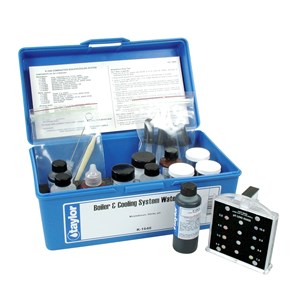K-1646
Boiler/Cooling Systems, Molybdenum/Nitrite/pH
- UPC Barcode:
- 840036011393
$247.81
Description of Tests
| Analyte | System | Method/Chemistry | Standard/Equivalance or Description | Comparator | Cell |
|---|---|---|---|---|---|
| Molybdenum | Drop test | Complexometric (uses powdered indicator for increased stability) | 1 drop = 2, 5, 20, or 50 ppm Mo | NA | 9198 |
| Nitrite (Sodium Nitrite) | Drop test | Permanganate | 1 drop = 50 ppm NaNO₂ | NA | 9198R |
| pH | Midget comparator | Long range | 3.0, 4.0, 5.0, 6.0, 7.0, 8.0, 9.0, 10.0 | 9052 | 4024 |
Potential Interferences
| Test Parameter | Description |
|---|---|
| Glycol may cause interference; to prevent, use "CAN" test method (cerium oxidation of nitrite) on glycol-treated systems. Quats may cause interference by forming a precipitate. | Nitrite |
| Iron > 10 ppm may cause negative interference. | pH |
| Ortho- and polyphosphate may cause positive interference; to prevent, test for interfering agent, dilute sample with DI water as necessary, and retest. | pH |
| Calcium salts may affect tolyl red indicator; to prevent, use acyl red indicator. | pH |
| Test should be run on clean, clear sample; filter out colloidal color and turbidity before beginning test procedure. High concentrations of HEDP (over 30 ppm) may cause positive interference; to prevent, test for interfering phosphonate, dilute sample with DI water as necessary, and retest. Thiocarbamate-based biocides may cause interference; to prevent, do not test while feeding thiocarbamates into water system. Sodium nitrite over 800 ppm may cause negative interference; to eliminate, dilute sample with distilled, deionized, or molybdenum- and nitrite-free water then retest. | Molybdenum |
Shelf Life Concerns
REAGENT SHELF LIFE
All reagents have a shelf life, whether they are liquids, powders, crystals, tablets, or test-strip pads. If kept dry, powders and crystals are very stable; acids are also long lived. Date of manufacture is not the controlling factor when it comes to shelf life—storage conditions are more important. As with all perishables, reagents are sensitive to environmental influences and will last longer under controlled conditions.
To this end, we recommend:
- Storing reagents at a consistent temperature in the range if 36°–85°F (2°–29°C); extreme temperature fluctuation, say from a refrigerator to a hot car trunk, causes reagents to deteriorate.
- Keeping them out of prolonged direct sunlight. (Note: their brown plastic bottles help protect very light-sensitive reagents.)
- Segregating reagents from containers of treatment chemicals.
- Replacing caps immediately and tightening them carefully so that exposure to air and humidity is limited.
- Avoiding switching bottle caps, placing bottle caps on soiled surfaces, repouring reagents into contaminated containers, or touching test strip pads.
Taylor formulates its reagents to remain effective for at least one year, with only very few exceptions (molybdenum indicator in liquid form is one; after four months old it should be tested against a standard periodically). As a general precaution, replace all reagents more than one year old, or at the beginning of a new testing season.



 0733
0733
